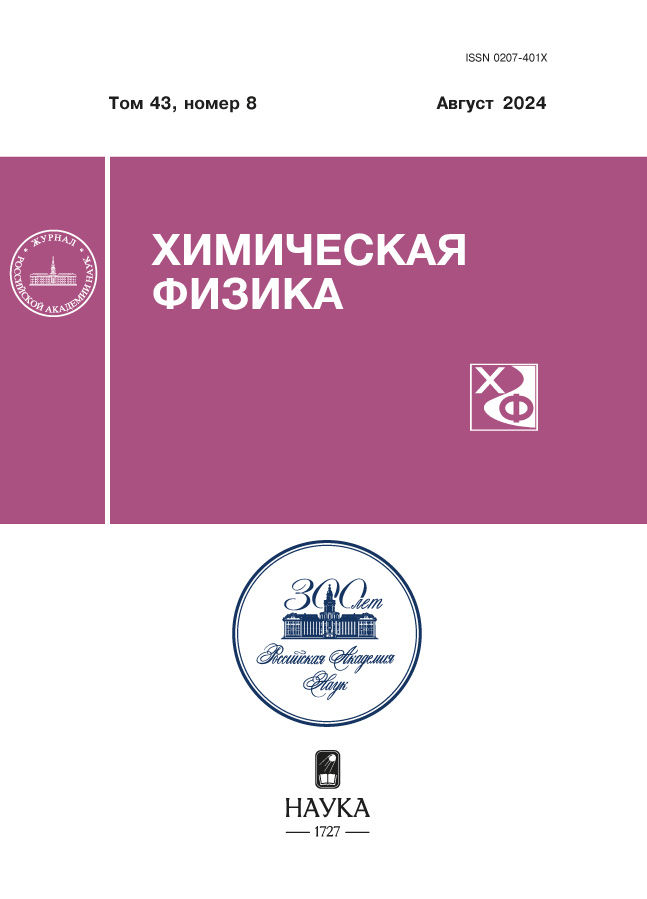Thermodynamic evaluation of hydrogen production modes during pyrolysis of ammonia in a filtration combustion moving bed reactor
- Authors: Salgansky E.A.1, Salganskaya M.V.1, Sedov I.V.1
-
Affiliations:
- FRC Problems of Chemical Physics and Medicinal Chemistry of the Russian Academy of Sciences
- Issue: Vol 43, No 8 (2024)
- Pages: 70-77
- Section: Combustion, explosion and shock waves
- URL: https://cijournal.ru/0207-401X/article/view/681886
- DOI: https://doi.org/10.31857/S0207401X24080088
- ID: 681886
Cite item
Abstract
A new process has been proposed for pyrolysis of ammonia in a filtration combustion moving bed reactor to produce hydrogen. The process can be implemented in reactors with energy recovery with separate supply of reagents (including swiss-roll reactor, etc.). The mass-energy balance of the process was calculated. The analysis of pyrolysis products was carried out under the condition of thermodynamic equilibrium with varying temperature and pressure. The system pressure varied from 1 to 10 bar. The temperature range from 300 to 1100 K was considered. It has been shown that ammonia pyrolysis ends at a temperature of 620 K at atmospheric pressure. An increase in pressure in the system led to a slight increase in the temperature of ammonia pyrolysis. The portion of hydrogen that needs to be burned to cover the energy for heating and pyrolysis of the initial ammonia in the case of an adiabatic reactor was 0.13. From one mole of ammonia it is possible to obtain 1.31 moles of hydrogen.
Keywords
Full Text
About the authors
E. A. Salgansky
FRC Problems of Chemical Physics and Medicinal Chemistry of the Russian Academy of Sciences
Author for correspondence.
Email: sea@icp.ac.ru
Russian Federation, Chernogolovka
M. V. Salganskaya
FRC Problems of Chemical Physics and Medicinal Chemistry of the Russian Academy of Sciences
Email: sea@icp.ac.ru
Russian Federation, Chernogolovka
I. V. Sedov
FRC Problems of Chemical Physics and Medicinal Chemistry of the Russian Academy of Sciences
Email: sea@icp.ac.ru
Russian Federation, Chernogolovka
References
- M. Romanello, C. Napoli, C. Green et al., The Lancet. 402, 10419 (2023). https://doi.org/10.1016/S0140-6736(23)01859-7
- G. Krauklit, and K. Aghayeva, Sciences of Europe. 110, 77 (2023). https://doi.org/10.5281/zenodo.7618453
- M. Mohammadi, H. Jafari, M. Etemadi, et al., Disaster medicine and public health preparedness. 17, 558 (2023). https://doi.org/10.1017/dmp.2023.225
- N.V. Lobus, M.A. Knyazeva, A.F. Popova, et al., C-Journal of Carbon. 9 (4), 120 (2023). https://doi.org/10.3390/c9040120
- K. Lianwei, P. Weiguo, Z. Jaikai, et al., Fuel. 332, 126150 (2023). https://doi.org/10.1016/j.fuel.2022.126150
- C. Tao, Z. Dan, and G. Ephraim, Chem. Eng. J. 458, 141391 (2023). https://doi.org/10.1016/j.cej.2023.141391
- Yu.V. Maksimov, V.K. Imshennik, S.V. Novichikhin, et al., Russ. J. Phys. Chem. B 17, 620 (2023). https://doi.org/10.1134/S1990793123030089
- S.M. Yunusov, E.S. Kalyuzhnaya, V.B. Shura, et al., Russ. Chem. Bull. 60 (9), 1842 (2011). https://doi.org/10.1007/s11172-011-0278-5
- S. Nithya, A. Chinnathambi, S. Ali Alharbi, et al., Fuel. 361, 130628 (2024). https://doi.org/10.1016/j.fuel.2023.130628
- V.F. Zakaznov, L.A. Kursheva, and Z.I. Fedina, Combust. Explos. Shock Waves. 14 (6), 710 (1978). https://doi.org/10.1007/BF00786097
- C. Lhuillier, P. Brequigny, N. Lamoureux, et al., Fuel. 263, 116653 (2020). https://doi.org/10.1016/j.fuel.2019.116653
- V.V. Kalinchak, A.S. Chernenko, V.V. Kulagin, et al., Khimicheskaya fizika. 35 (2), 61 (2016). https://doi.org/10.7868/S0207401X16020060
- Y. Tang, D. Xie, B. Shi, et al., Fuel. 313, 122674 (2022). https://doi.org/10.1016/j.fuel.2021.122674
- A. Valera-Medina, M.O. Vigueras-Zuniga, H. Shi, et al., Int. J. Hydrog. Energy. 49, 1597 (2024). https://doi.org/10.1016/j.ijhydene.2023.10.241
- M. Kovaleva, A. Hayakawa, S. Colson, et al., Fuel Commun. 10, 100054 (2022). https://doi.org/10.1016/j.jfueco.2022.100054
- A. Alfazazi, E. Es-sebbar, X. Zhang, et al., Appl. Energy Combust. Sci. 12, 100099 (2022). https://doi.org/10.1016/j.jaecs.2022.100099
- K.P. Shrestha, B.R. Giri, A.M. Elbaz, et al., Fuel Commun. 10, 100051 (2022). https://doi.org/10.1016/j.jfueco.2022.100051
- P. Ronan, B. Pierre, M.R. Christine, et al., Fuel Commun. 10, 100052 (2022). https://doi.org/10.1016/j.jfueco.2022.100052
- J.S. Cardoso, V. Silva, J.A.M. Chavando, et al., Fuel Commun. 10, 100055 (2022). https://doi.org/10.1016/j.jfueco.2022.100055
- B. Mei, J. Zhang, X. Shi, et al., Combust. Flame. 231, 111472 (2021). https://doi.org/10.1016/j.combustflame.2021.111472
- K. Ryu, G.E. Zacharakis-Jutz, and S.C. Kong, Int. J. Hydrog. Energy. 39 (5), 2390 (2014). https://doi.org/10.1016/j.ijhydene.2013.11.098
- S.S. Gill, G.S. Chatha, A. Tsolakis, et al., Int. J. Hydrog. Energy. 37 (7), 6074 (2012). https://doi.org/10.1016/j.ijhydene.2011.12.137
- A. Mercier, C. Mounaïm-Rousselle, P. Brequigny, et al., Fuel Commun. 11, 100058 (2022). https://doi.org/10.1016/j.jfueco.2022.100058
- O.S. Rabinovich, A.I. Malinouski, V.M. Kislov, et al., Combust. Theor. Model. 20 (5), 877 (2016). https://doi.org/10.1080/13647830.2016.1190034
- L. Jiaxin, Y. Guangyao, W. Shixuan, et al., Fuel. 349, 128740 (2023). https://doi.org/10.1016/j.fuel.2023.128740
- M.A. Mujeebu, Appl. Energy. 173, 210 (2016). https://doi.org/10.1016/j.apenergy.2016.04.018
- B.G. Trusov, Proceedings of the 14th International Conference on Chemical Thermodynamics (NIIKh SPbGU, St. Petersburg). 483 (2002).
- V.V. Petrov, Y.N. Varzarev, A.P. Starnikova, and Kh.A. Abdullin, Russ. J. Phys. Chem. B 14, 117 (2020). https://doi.org/10.1134/S199079312001025X
- F.F. Tabrizi, S. Mousavi, and H. Atashi, Energy Convers. Manag. 103, 1065 (2015). https://doi.org/10.1016/j.enconman.2015.07.005
- A.M. Tereza, S.P. Medvedev, and V.N. Smirnov, Acta Astronaut. 176, 653 (2020). https://doi.org/10.1016/j.actaastro.2020.03.045
- A.M. Tereza, and E.K. Anderzhanov, Russ. J. Phys. Chem. B 13, 626 (2019). https://doi.org/10.1134/S1990793119040262
- A.M. Tereza, P.V. Kozlov, G.Y. Gerasimov, et al., Acta Astronaut. 204, 705 (2023). https://doi.org/10.1016/j.actaastro.2022.11.001
- E.A. Salgansky, A.Yu. Zaichenko, D.N. Podlesniy, et al., Fuel. 210, 491 (2017). https://doi.org/10.1016/j.fuel.2017.08.103
- M. Toledo, A. Arriagada, N. Ripoll, et al., Renewable Sustainable Energy Rev. 177, 113213 (2023). https://doi.org/10.1016/j.rser.2023.113213
- M.V. Salganskaya, S.V. Glazov, E.A. Salganskii, et al., Russ. J. Phys. Chem. B 2 (1), 71 (2008). https://doi.org/10.1134/S1990793108010119
- M.V. Tsvetkov, and E.A. Salganskii, Russ. J. Appl. Chem. 91 (7), 1129 (2018). https://doi.org/10.1134/S1070427218070108
- M.V. Grishin, A.K. Gatin, V.G. Slutsky, et al., Russ. J. Phys. Chem. B 12, 937 (2018). https://doi.org/ 10.1134/S1990793118050068
Supplementary files













